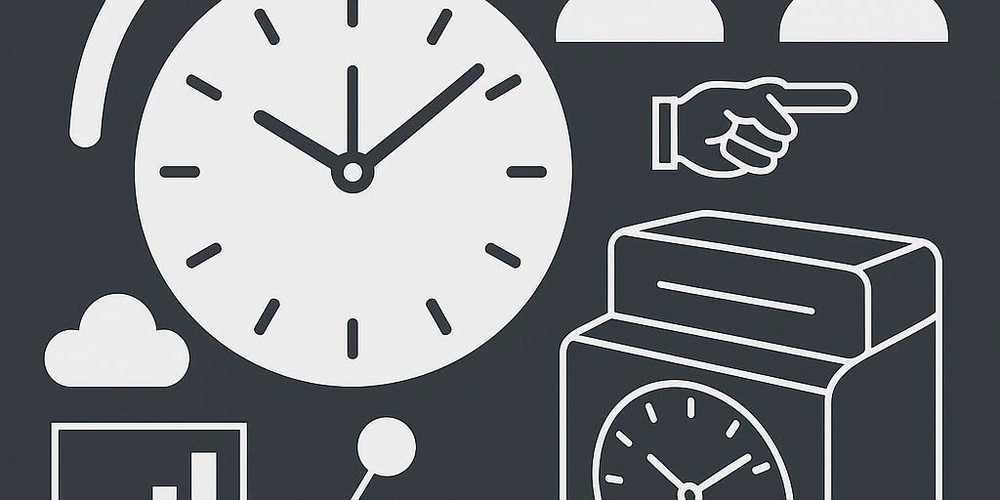By Oliver Otto, CEO of TimeSpin GmbH
1. Introduction: The Moment Time Slips
Twice a year, something happens that affects the daily rhythm of millions of people across Europe — the clock change.
Whether in spring, when the night becomes one hour shorter, or in autumn, when darkness arrives earlier —
the time change impacts far more than just clock hands. It’s a social experiment that’s been debated for decades by politicians, economists, scientists, and citizens alike.
In recent years, discussions about the usefulness of this measure have intensified.
The European Union decided in 2019 to abolish the time change permanently — yet it remains in place because member states haven’t agreed on a common time zone.
Germany, as Europe’s economic engine, stands as a prime example of the tension between tradition and efficiency, between biological rhythm and economic rationality.
This article explores the economic, organizational, and societal effects of the time change — and shows why modern work environments and digital time tracking systems like TimeSpin can help businesses handle the “time shift” more effectively.
2. Historical Development: From Wartime to Office Time
The idea of changing the clocks isn’t new.
As early as 1916, the German Empire introduced daylight saving time during World War I — aiming to save energy by making better use of daylight.
This pragmatic approach — “more light, less electricity” — dominated the discussion for decades.
After the war, the practice was repeatedly abolished and reintroduced until it became permanent in 1980 in West Germany.
The main driver at the time was the oil crisis of the 1970s — energy was scarce and expensive, and efficiency became a national duty.
Daylight saving time was seen as a symbol of modern rationality: a simple administrative step to save energy and money.
However, later studies revealed that actual energy savings were marginal.
While heating started later in the morning, evening lighting and cooling increased — especially in air-conditioned offices and server rooms.
Over time, the time change became a cultural and organizational routine — its usefulness questioned, but its removal potentially more complex.
3. Societal and Political Context in Europe
The time change is no longer just a technical or energy issue — it’s a symbol of European disunity.
In 2018, the European Commission conducted a public survey: over 4.6 million EU citizens participated, and more than 80% voted to end the biannual clock change.
Germany led the opposition, with 84% of participants wanting it abolished.
Yet progress has stalled.
EU countries couldn’t agree whether to keep permanent summer time or permanent winter time.
Southern countries like Spain or Italy favor longer evening daylight, while northern countries like Finland or Denmark fear late winter sunrises.
For businesses, this political deadlock means planning uncertainty.
Flight schedules, train timetables, shift work, and international collaboration all depend on synchronized time zones.
A national solo move would be risky — especially in an integrated single market that relies on precise time coordination.
4. Economic Effects: Between Productivity and Cost
4.1. Energy Savings – A Modern Myth
Several studies — including those from Germany’s Federal Environment Agency — show that time changes save less than 0.1% of energy.
Modern buildings with automated lighting and climate control don’t respond linearly to daylight changes.
The supposed efficiency is neutralized by higher usage elsewhere.
4.2. Productivity Drops After the Switch
Research from the Technical University of Munich shows that after switching to summer time, average sleep duration drops by up to 40 minutes.
That leads to irritability, reduced concentration, and even a measurable +8% increase in workplace accidents (according to DGUV data).
In companies with complex time models — like shift work or cross-border projects — the time difference can cause scheduling errors, incorrect time logs, and payroll mismatches.
4.3. Administrative and IT Costs
Digital infrastructure also suffers.
Servers, databases, and time-tracking systems must be double-checked for synchronization.
Large enterprises allocate IT resources just to handle this transition — resources that could be better used elsewhere.
In Germany alone, the indirect cost of time changes is estimated between €100–200 million annually.
5. Psychological and Health Aspects
The human body runs on an internal clock — the circadian rhythm — that regulates sleep, energy levels, hormones, and even immunity.
A one-hour change acts like a mini jet lag.
Common short-term effects:
Increased cardiovascular risk in the first days after the switch
Fatigue and reduced focus while driving
Higher error rates in jobs requiring high alertness
Shift workers, commuters, and parents of small children are hit the hardest — their biological rhythm doesn’t adapt overnight.
6. Impact on Companies and Work Organization
Modern workplaces rely on digital and cloud-based time management systems.
Remote work, flexible hours, and integrated HR systems (like TimeSpin or Microsoft 365) all depend on accurate time data.
6.1. The Organizational Burden
Small and medium-sized businesses must check each time change to ensure time-tracking tools, calendars, and shift plans are synchronized.
Even a one-hour mismatch can cause incorrect logs or billing discrepancies.
6.2. Home Office and Asynchronous Teams
With remote and hybrid work now common, precise time-tracking systems are more critical than ever.
Teams spread across time zones need transparent and fair tools to log working hours accurately.
That’s where modern solutions like TimeSpin shine:
A system that works both physically (through tangible devices like the TimeSpin cube) and digitally (via cloud sync and API integration) can greatly reduce organizational stress.
7. Digitalization and the New Culture of Time
Digitalization doesn’t just change when we work — it changes how we perceive time.
Flexible schedules, trust-based working hours, and AI-driven workload analytics are decoupling productivity from fixed hours.
But that also means reliable time-tracking becomes essential.
It ensures transparency and fairness for both employers and employees.
The time change highlights a deeper issue:
Many companies have digital tools, but analog mindsets.
The real challenge isn’t the one-hour shift — it’s the rigidity of outdated structures.
8. Legal and Labor Framework
Germany’s Working Hours Act (ArbZG) defines strict rules for daily and weekly working hours.
The time change cannot legally disadvantage employees.
All working hours must be recorded correctly — even if an hour “disappears” or “repeats.”
Since the 2019 European Court of Justice ruling (C-55/18), all companies must objectively record employee hours.
That means even during the time change night, hours must be logged precisely — a nightmare for manual systems, but easily handled by digital solutions like TimeSpin Cloud.
9. The Future of Time Organization in Europe
Europe stands at a crossroads.
The abolition of the time change is agreed upon — but not implemented.
More and more countries push for national solutions, which could disrupt cross-border coordination.
The future of time isn’t about unification — it’s about flexibility:
AI-driven scheduling that adapts to individual biorhythms
Smart time-tracking systems that auto-adjust for time zones
Adaptive lighting systems that stabilize human performance
In the near future, humans won’t follow the clock — the clock will follow humans.
10. Conclusion & Practical Example: TimeSpin as a Modern Solution
The time change perfectly illustrates how deeply our work rhythm is tied to organization and technology.
It reminds us that time is not a static metric — it’s a resource.
How we manage it determines productivity, health, and satisfaction.
TimeSpin directly addresses this challenge.
It’s a physical time-tracking cube with digital intelligence — turn it to switch between “Project A” and “Project B.”
All data syncs instantly to the cloud, integrating with ERP, HR, or billing systems.
In a world where even the clock changes twice a year, TimeSpin brings what’s rare in modern work life:
Stability. Simplicity. Transparency.
Because in the end, time isn’t what the clock shows —
it’s what we make of it.



